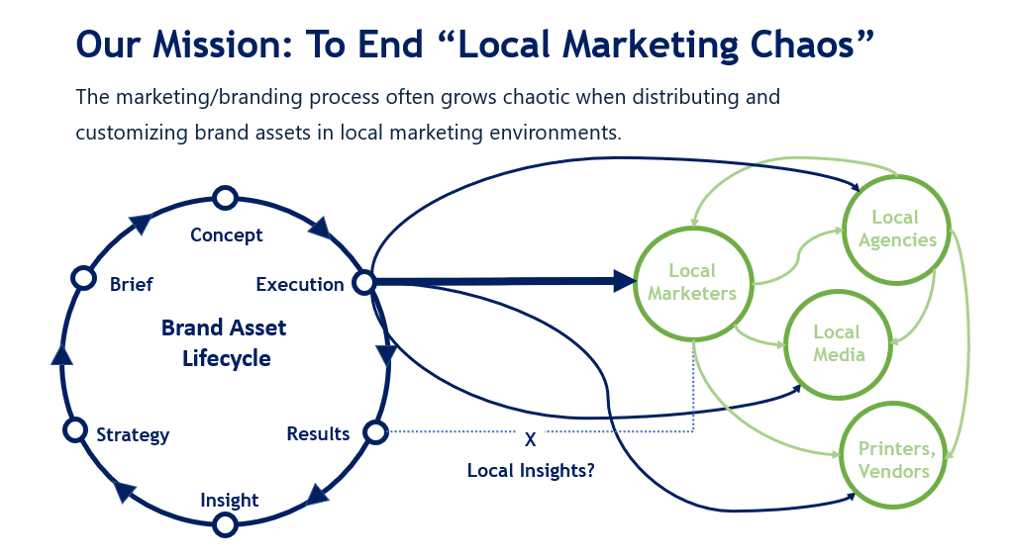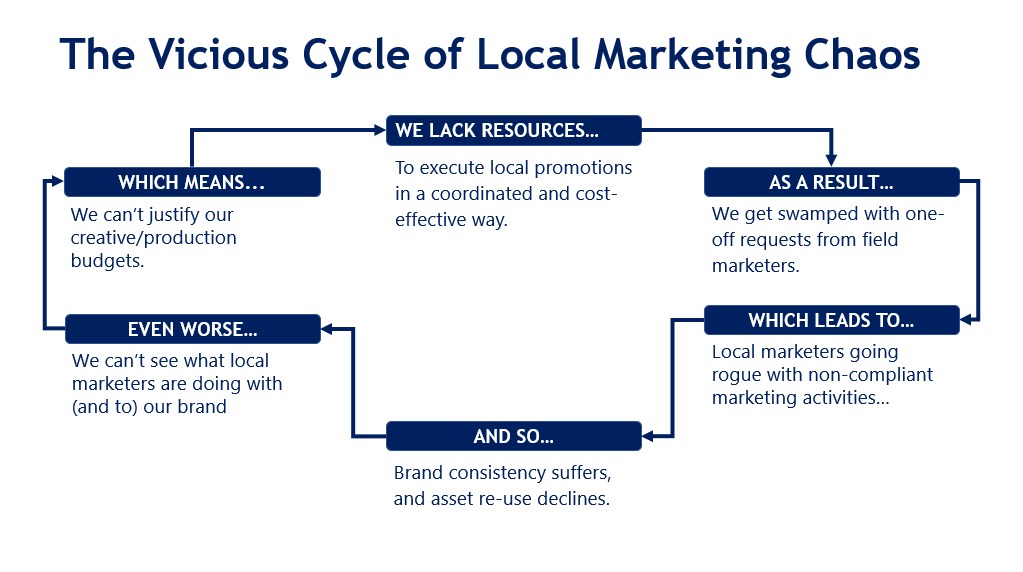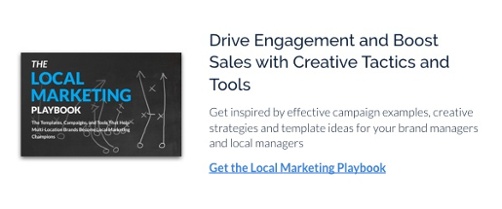Local marketing chaos is a condition that arises in multi-location businesses when local marketers (franchisees, resellers, dealers, etc.) stray from brand standards and strategies in their efforts to increase revenues for their individual operations.

Warning Signs of Local Marketing Chaos
In-House Agency Overload: Most businesses detect the first signs of local marketing chaos within their in-house agency or in-house brand management team, which suffer from a continuing stream of “one-off” requests from local marketers for production and execution support. Usually, these requests create difficulty because they distract the creative team from larger, more strategic initiatives—and yet, the requests can’t simply be ignored without damaging the relationship between the brand and its local outlets.
How can you detect this symptom? Certainly, a quick conversation with your in-house agency leader should reveal it. But so, too, can time records for your field support and graphic design teams. Or, if your creative team is using a job-ticketing system, you should find evidence there.
Another method for detecting in-house agency overload comes from “managing by walking around.” Take a moment to learn about the day in the life of your in-house creative team. If they talk about “putting out fires” or “endless rounds of revision,” then you may have some local marketing chaos on your hands.
Off-brand executions at the local level. The second symptom of local marketing chaos often goes undetected—precisely because many brands have no simple way to keep an eye on marketing executions at the local level. Certainly, you might be able to see some signs of off-brand executions by reviewing the “tear sheets” in an advertising co-op program (tear sheets are samples of the local marketing, provided to prove that media dollars were spent and rules obeyed). But in most cases, off-brand executions occurred in areas where review is much more spotty—local web partnerships, social media tactics, local direct mail campaigns, etc.
The best way to put your ear to the ground for this is to leverage your field support teams, who are responsible for visiting local stores (restaurants, branches, etc.). Ask them to subscribe to or in other ways participate in the marketing efforts that their locations are mounting: email newsletters, business-card signups, Money-Mailer, or PennySaver mailings. Then ask them to drop the executions off at headquarters whenever the opportunity presents itself (often a smartphone screenshot will do). Over time, this kind of background auditing can help you to determine if your brand is getting activated with an acceptable degree of discipline at the local level.
Dissatisfaction among local marketers: Where off-brand executions can be easy to miss, dissatisfied franchisees or resellers usually make themselves well known—especially if they are influential in the network. But don’t assume that no news from the locals is necessarily good news. Instead, take the initiative and reach out for some one-on-one conversations with local marketers of different sizes, and different geographic regions. Probe for signs not merely of dissatisfaction, but disengagement, which can be the “silent killer” from a brand activation point of view. Be aware that revenue numbers from a local marketer may be in line with expectations, even though brand activation for that location is sub-par. That’s because a drop-off in brand activation is a leading indicator of revenue problems in the future. In that light, you can see brand activation as a kind of “canary in the coal mine” of your local marketing ecosystem.
Disregard from brand management: This is the flip side of dissatisfaction in the field. When local marketing chaos persists for a long period of time, a rift can emerge between headquarters and local marketers, where the two sides become resentful, even adversarial. If you find that the brand team is discounting local perspectives, or is lacking in curiosity and empathy about the day in the life of the local marketer, you’ve probably got some local marketing chaos brewing. If, on the other hand, your creative teams are eager to get input from the field during the creative briefing process, and if they welcome field perspectives in the review of new campaigns, then you’ve likely got a virtuous cycle going, where HQ-to-field bonds are growing stronger over time.
It’s easy to understand why HQ-based marketer and creatives might be tempted to overlook field perspectives. If their work has been discarded, or disregarded in the past, the marketing pros may feel that it’s better to keep their own counsel and get their work into the field “undiluted”. But in a world where customers own the brand as much as HQ does, this can be a fast track toward irrelevance.
Difficulty justifying budgets: If you see your budgets for local marketing production falling, this is probably a sign that local marketing chaos has already taken a toll. You may find that there’s no easy way to correlate the performance of locations in the field with marketing activities. You may find that assets that were produced at significant expense have sat unused on the “shelves”. You may also discover that local marketers are talking about a lack of support from HQ, even when you’ve been working diligently to provide just that. And the tough thing is, if your budgets fall, it’s going to be harder to correct the problem next year than it would have been to address it last year. This is the “vicious” part of the cycle of local marketing chaos; budgets get thinner even as the problem grows more severe.

Causes of Local Marketing Chaos
Typically, local marketing chaos arises from three main causes. As you’ll see, most of these problems are human factors, stemming from behavior rather than some flaw or shortcoming in technology. However, technology can be used to address and minimize the root causes of local marketing chaos.
- Brand culture isn’t fully defined or enforced: In many environments, the headquarters team doesn’t have the authority or the resources to keep a close eye on brand activation at the local level. Well-intentioned efforts to publish brand standards and guidelines often go unnoticed, because local marketers don’t intuitively see the advantage of utilizing these kinds of tools. Instead, they see brand guidelines as “handcuffs” that limit their ability to get the marketing part of their jobs done.
- Local market visibility is limited. From a technology point of view, in-house agency and HQ marketing teams often find themselves pushing out large volumes of brand-created materials, with little or no sign as to which programs and tactics are actually being used at the local level. The problem of visibility is often complicated through the use of widely available file-sharing tools, like Google Drive and DropBox, which have sprung up in recent years because of their simplicity and broad availability. Once they have taken root in a distributed marketing ecosystem, it’s often difficult to supplant them with tools that offer greater security and visibility.
- Local marketers “wag the dog”: Whether you’re working with franchisees, resellers, or internal salespeople, you’ll often find that a small number of players wield out-sized influence, either because of their long tenure within the ecosystem or because they have a disproportionate impact on sales. These players can make the argument that the importance of revenue trumps the value of brand integrity. They often have an inside track with senior management and can be “squeaky wheels” that distract the HQ marketing team with numerous one-off projects and last-minute requests.
How to Avoid Local Marketing Chaos
Know Your Customer.
To address the problem of local marketing chaos effectively, you need to put yourself in the shoes of your local partners. Remember that, as a brand-level marketer, 100% of your job is devoted to the challenges of marketing. But for local partners, marketing is just one of a dozen different hats they’re likely to wear.
To develop this perspective, you might try sending a simple, five-question local marketing survey. Done correctly, the survey will help you understand your local partners’ marketing frequency, brand savvy, technology skillset, and appetite for self-service. If your community is like most, you’ll find a broad spectrum of experience levels and attitudes about marketing, which will enable you to tailor your delivery of brand materials based on what works best for different kinds of local partners.
Local marketing partners:
When you find out who your local partners are marketing with and through—local websites, newspapers or magazines, offer-driven direct mail, etc.—you’ll be able to determine much more quickly and effectively what kinds of brand materials to provide.
Design savvy:
Some local marketers are familiar with the basic principles of good graphic and communications design. But this expertise at the local level is the exception, not the rule. Usually, that means you’ll need to deliver brand templates that are locked down to a large degree, to help insulate local marketers from the chance of making a mistake. But in some cases, you’ll want to take special care to acknowledge those local marketers who actually have design and branding expertise and try to feed, rather than frustrate, those skills. This means finding a brand-to-local platform with good permission-based delivery, so you can support your marketing novices and experts alike.
Technology skills:
Use your initial user assessment to get a sense of the devices that your local marketers most often use. Are they heavily focused on computers, or have tablets begun to dominate? Do they use smartphones to execute some or most of their marketing tasks? Use these insights to evaluate the user experience of martech platforms, to make sure you’ve got a good fit, both for your headquarters crew and users in the field.
Appetite for self-service:
More and more every day, consumers are looking for systems and tools that allow them to do what they want, when they want, without assistance or intervention. The same is true for many local marketers today. But don’t simply assume that your entire community is eager for a self-service model. Some local marketers may feel that the brand is attempting to foist a burden of work onto them that wasn’t theirs previously and may resist.
Be sure to include time in your launch plan to communicate the benefits of the self-service model, in terms of greater freedom, faster turnarounds, and lower costs. Listen carefully when users point out potential sources of friction, and turn to your team and your vendor to help smooth out those details of the user experience.
Tailor Delivery to the Local Marketer’s Needs
In our experience, the #1 complaint that local marketers make about brand delivery tools and systems is that the materials they need are too difficult to find, and once located, too difficult to use. In large part, these complaints can be solved with just a bit of empathy on the brand side. When organizing your materials, be sure to speak the language of the local marketer, rather than the language of the studio artist.
Take file naming as an example. If you load up an asset with the filename Broch_21_v3c_cmyk.eps, you can be pretty sure that your graphic design team will know exactly what it is—and local marketers won’t have a clue. Instead, avoid abbreviations and terms of art from graphic design. Call that file “2021 Sales Brochure”. Make sure to provide it in a format that a local marketer can view and use without access to the Adobe Creative Suite. And while you’re at it, try to keep file sizes within reason, as local marketers often find themselves challenged by less-than-adequate bandwidth.
Time-Release Your Content; Don’t Dump It. A common mistake that many brands make when setting up a local marketing portal is to stuff every conceivable asset into the system. While the intent may be good (to create a true ‘one-stop shop’, the effect on end users is to bury the things they need in a nest of content that, right now, they don’t. In our experience, the best approach to information architecture is minimalist. Think about what your local marketers need today, this month, or at most, this quarter. Organize your library so those assets are immediately visible upon login. When those materials are no longer relevant, de-prioritize them and replace them with newly relevant tactics. Yes, this takes work; it’s a maintenance task that you don’t need to think about when you are working with fellow marketing professionals alone. But when supporting local marketers, it’s vital for success—and failure to engage in this kind of constant curation is one of the chief causes for disappointing adoption numbers.
Recognize and Reward Good Behavior: This one seems so obvious, and can be so simple to execute, that it’s surprising how few brands engage in reward behavior. But take the time each month to review the tactics that your local marketers have produced using your local marketing system. Identify a few that you can promote as “best practices” and give the creators public recognition.
Even further, use your approval process on the system to praise the work that local marketers are doing. Take time to notice good choices in photography, or attention to detail in copywriting. Remember that your local marketers are often taking on these tasks for the first time; a little reinforcement from you takes just a few seconds, and can have a huge impact on motivation.
3 Signs of Local Marketing Success
Properly configured and maintained, a local marketing system will have an almost immediate impact on the problem of local marketing chaos. Here are a few signs that you’ll see telling you that you’re on the right track.
- One-off requests from the field begin to decline—significantly. In our experience with hundreds of brands over the years, we have seen drops of 50-60% in one-off requests within three months of launch, and continued declines thereafter. The pace with which your users adopt the system will relate directly to the effectiveness of your system set-up, so if you find that your results aren’t in this ballpark, take the time to determine why, and make adjustments. From time to time, use our Heath Grade Calculator, to see how your system-adoption and impact compares with broad norms.
- Brand consistency improves substantially. By supplying brand templates and assets in an easy-to-use environment, you can make brand consistency the “path of least resistance” for your local marketers. This should result in a visible reduction in off-brand or non-compliant executions.
- Increased Asset reuse: Having spent great amounts of time and cash in the production of brand assets, you’ll be gratified to see those materials put to good use in local marketplaces at a much higher frequency than previously. Make sure that your brand-to-local portal provides clear reporting on this usage, as it will be invaluable when demonstrating the impact of your creative operations during planning and budgeting discussions.
How to Win the Local Marketing Chaos Battle and Empower Local Marketers
If excess one-off requests and off-brand executions have been troubling your organization, execute the steps below to define, address, and permanently control the problem.
- Examine and quantify the problem. Measure the number of one-off requests your in-house team has been receiving and quantify the hours lost to these repetitive tasks.
- Assess the mindset, skillset, and temperament of your local marketing community. Take care to tailor the content set and user experience of your solution to those characteristics.
- Release your content in controlled, well-timed bursts. This will simplify execution for your local marketers, and train them in the proper cadence and sequencing of effective marketing campaigns.
Finally, monitor the use of the system regularly (at least weekly), and be sure to recognize and reinforce the proper and effective use of brand assets. Use the lessons you’ve learned to adjust and optimize the delivery of creative in the next marketing cycle, and leverage signs of increased usage to demonstrate the ROI of your marketing and creative-production operations.
CampaignDrive by Pica9 is a distributed marketing platform that frees multi-located brands from the vicious local marketing chaos cycle. Speak with a local marketing expert today.







